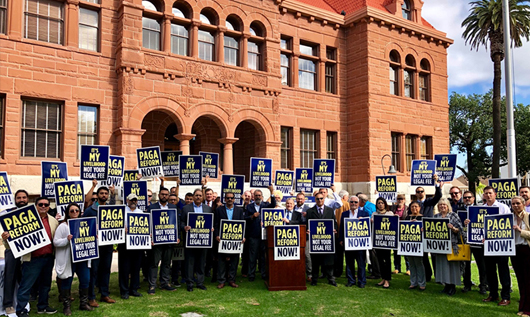Opinion
PAGA Settlement Threats

The Private Attorney General Act (PAGA) has become a weapon used by unscrupulous trial attorneys to extort millions from business owners and non-profit organizations. Grey Davis and Joe Dunn championed this law in 2004 and Grey Davis was recalled due to gross mismanagement of California finances. Joe Dunn was recently fired as executive director of the California State Bar due to excessive international travel expenses. The bottom line is the two individuals who set this law up have a track record of illegal behavior.
PAGA is known as the “Sue Your Boss Law”, and minor infractions such as missing a period on a paycheck stub or incorrect employee ID could cost an employer millions. The state thought it was a good idea to deputize employees to enforce labor law violations with their attorneys. My question is with a California Labor Law Digest of over 1,100 pages how are the deputized citizens capable of knowing what is right or wrong with the influence of trial attorneys?
In a recent Detroit Free Press article it states across Michigan, police departments have enlisted civilians to work alongside licensed officers to patrol communities and even assist real cops with arrests. But unlike the regular officers licensed by the state, these armed civilians are unregulated. The state agency responsible for police licensing and training is not regulating reserve officers despite gaining authority last year to do just that and has no idea how many such unlicensed volunteers there are statewide. This lack of oversight continues despite numerous incidents of questionable even illegal conduct by reserve officers in recent years.
Does this sound familiar? We should evaluate a few cases and see what you think. One manufacturer in souther California offered a flexible work schedule with employees coming in at various start times. The company was doing what they thought was a good thing. The employees who were friends and family wanted to eat together and some ate beyond 5 hours, anywhere from 10 minutes to 40 minutes. The penalties and fines cost over a million dollars. Another company who had been in business since the 1940’s had a start time at 5:00 and lunch hour at 11:00 and had been doing this since they started. No one ever complained, they got their break in between, although their lunch was taken beyond 5 hours and cost the over $500,000. What is worse is the trial attorneys get the majority of these settlements while the employees end up with pennies.
If a disgruntled employee was not influenced by a trial attorney this case would of never taken place and there would not be more than 5,000 cases a year filed jamming up the courts. UBER was sued under PAGA and each employee received $1.08 each and the trial attorneys took home over 2.6 million dollars!
This law is only in California and needs to be repealed, just like Grey Davis. There have been many legislative attempts although the trial attorneys deep pockets have paid off with donations during election season. Labor turns a blind eye as if you are unionized and have a collective bargaining agreement, you don’t even need to take a lunch. This fix is simple, right the wrong and change this law. Since 2004 there have been more than 35,000 victims and counting.
Opinion
Despite Popular Narratives, California’s Economy is Doing Fine…For Now

Leading Economic Forecast Pushes Back Against “Doom and Gloom” Prophecies; State’s Housing Supply Problem At The Crux Of Slowing Economy
California is far from becoming the ‘failed state’ depicted by critics, and even a cursory look at the data proves it, says one of the state’s leading economic forecasts. According to Beacon Economics‘ latest outlook for California, the state’s economy will continue to grow in the near future and there is little sign of a recession in 2024.
Consider a few of the new forecast’s findings:
- Since just prior to the pandemic, the number of jobs in California has grown by only 2.1%, compared to 3.7% in the nation as a whole, however, the state’s private sector output has grown by 10% compared to just 8% in the nation overall. This means that California’s output has expanded through greater worker productivity.
- California’s median household income grew by 9.2% from 2019 to 2022, compared to just 8% growth in the nation overall. Median incomes in the state are now 14.3% higher than in the U.S. as a whole, the largest gap ever seen in this data.
- Real income (accounts for inflation) has increased despite persistent claims to the contrary. Official data from the U.S. Bureau of Labor Statistics shows a 20% increase in consumer prices in California between the end of 2019 and the end of 2023, but a 23% increase in workers’ average weekly earnings over the same period. Importantly, the earnings growth has been greatest among lower skilled workers, according to the new forecast.
- From 2019 to 2022, the average poverty rate in California was 12%, lower than the U.S. average and the lowest level ever seen in the state.
The new forecast is careful to acknowledge California’s glaring problems, including its housing shortage and massive budget deficit, but argues that untruthful and excessively negative narratives are making things materially worse by affecting the way leaders spend their time and do their jobs.
“The state’s economy certainly has its share of problems, but many of these issues are things that can be solved with some pragmatic changes to state policy,” said Christopher Thornberg, Founding Partner of Beacon Economics and the forecast author. “When pessimistic public narratives take hold, no matter how false or overblown, elected leaders tend to veer off on impractical missions to fix problems that don’t really exist – at least not in the way these artificial narratives say they do.”
One of the most urgent, and real, challenges facing California this year is it’s colossal budget deficit of between $35 and $70 billion, depending on who you ask. But according to the new forecast, this gap is not a function of the state’s economy, which is growing, it is the obvious (and oft repeated) result of a volatile revenue system that badly needs to be overhauled.
“California loves soak-the-rich policies, and our high marginal tax rate on high-income earners means that when financial markets are hot, revenues surge, but when asset values fall or crash, it cuts deeply into the state’s tax haul,” said Thornberg. “On top of that, we have a mishmash of band aid type laws that have been put in place over the years which force a certain amount of spending, preventing lawmakers from saving for lean times.”
All that said, according to Thornberg, California’s biggest budgetary problem today is not with revenues but expenditures. “State spending is currently 40% higher than it was pre-pandemic, and as painful as it is, the deficit will not fully go away until either programs are cut back or new taxes are raised, both of which would be incredibly difficult to achieve,” he said.
In terms of the state’s economic future, perhaps California’s most burning dilemma is its low supply of housing, which has driven infamously high housing costs and a declining population, ergo workforce. According to the forecast, the only way to fix the problem is to sharply expand the pace of new housing supply. “This is a tremendously consequential issue for the economy and population of the state – a workforce cannot grow if there is nowhere for workers to live,” said Thornberg. “The inability to genuinely tackle our housing supply issue is slowing the mighty California economic machine and the effects we’ve started to see in the past few years will only grow worse.”
View the new The Beacon Outlook California including full forecast tables here.
Education
Unlocking Potential: Fostering Inclusion and Innovation through Entrepreneurial Education at REAL Journey Academies

The REAL Journey Academies Entrepreneur High School Model / Inclusive Education Programming
Inclusive education is a fundamental right for all students. REAL Journey Academies was founded on this principal. The unique high school programs of Entrepreneur High Schools in Fontana and San Bernardino integrate entrepreneurship and career & technical education (CTE) to offer a unique opportunity to unlock the potential of students and prepare them for success in the constantly evolving century workforce. By providing tailored support, fostering self-confidence, and nurturing entrepreneurial skills, our unique high school program empowers students with IEPs and hidden talents to thrive academically, professionally, and personally.
This white paper explores the values of our entrepreneurship focused high school program for students with IEPs and hidden talents, highlighting the program’s potential to promote inclusion, boost self-esteem and cultivate a culture of innovation and entrepreneurship. The value proposition of our programming, in relationship to inclusive education, include:
- Promoting Inclusion:
- Our entrepreneurship focused program focuses on full inclusion by providing students with diverse learning needs, including those with IEPs and hidden talents, with opportunities to actively participate in hands-on, experiential learning experiences.
- By embracing diversity and fostering a sense of belonging, the entrepreneurship focused program of REAL Journey Academies empowers all students to realize their full potential and become active members of their communities.
- Boosting Self-Esteem:
- Entrepreneurship focused programming at its core boost self-esteem and confidence by recognizing and celebrating students’ individual strengths, interests, and talents.
- Through project-based learning and real-world experiences, students in an Entrepreneur High School have the opportunity to showcase their skills, gain recognition for their achievements, and build a positive sense of self-worth.
- Our program is designed to give students the support and encouragement they need to overcome challenges, set ambitious goals, and pursue pathways to success that align with their unique abilities and aspirations.
- Cultivating a Culture of Innovation:
- Our entrepreneurship focused program cultivates a culture of innovation by encouraging students to think creatively, problem-solve collaboratively, and pursue their entrepreneurial dreams.
- By providing students with the tools, resources, and mentorship they need to explore their passions and develop their talents, the unique Entrepreneur High School Program is designed to inspire a lifelong love of learning and skills associated entrepreneurship.
- Through extensive work-based learning experiences and real-world projects, Entrepreneur High School students have the opportunity to unleash their creativity, tap into their potential, and make meaningful contributions to society.
The REAL Journey Academies’ entrepreneurship focused high school program has immense value for all students, including those with IEPs and hidden talents. By promoting inclusion, boosting self-esteem, and cultivating a culture of innovation, at its foundation our program is designed to empower students to overcome barriers, fulfill their potential, and pursue their dreams. As we strive to build a more equitable and inclusive society, investing in developing entrepreneurial skills in students with diverse learning needs is not only a moral imperative but also a strategic investment in our collective future
Opinion
Rethinking Dynamic Pricing: Wendy’s CEO Pulls Back on Controversial Strategy

A strategic retreat sheds light on the complexities of surge pricing in the fast-food industry and the importance of customer perception
By Sandeep Krishnamurthy and Christopher Tang, IEBJ Contributors
What a difference a day makes. Wendy’s CEO, Kirk Tanner, retracted his decision to introduce a dynamic pricing plan on February 28. This reversal came just a day after his statements about the 2025 launch of dynamic pricing were reported in a February earnings call.
Dynamic or surge pricing, regardless of the terminology used, is generally not favored by customers, particularly in restaurants, pubs, or supermarkets. To successfully implement dynamic pricing, companies need to understand customer psychology and must effectively explain their approach to customers.
The obstacles that Mr. Tanner is encountering are not unique, and there are valuable lessons to be gleaned from his experience.
First, low hanging fruits may not be beneficial.
As the newly appointed CEO of Wendy’s since January, Mr. Tanner faced the daunting task of devising a plan to revive the company following a 14% drop in its stock price in 2023.
One potential strategy to boost profits involves using an AI-enabled system to dynamically promote different items at varying prices, potentially encouraging customers to order and spend more. As reported in the press, Tanner had unveiled new strategies during the February earnings call to enhance Wendy’s profitability. These strategies included digital menu boards capable of real-time price updates and diverse menu offers throughout the day.
While Mr. Tanner might consider this approach a no-brainer, he should be aware of past instances where similar plans were met with resistance. Rumors circulated in 2017 that UK supermarkets like Tesco, Sainsbury’s, and Morrisons were planning to use electronic labels for dynamic price changes. However, they subsequently denied these plans following customer backlash.
The implementation of dynamic pricing in restaurants and supermarkets carries inherent risks of customer defection and loss of brand reputation. This is why so few companies dare to pick this low-hanging fruit.
Second, transparency and honesty are paramount when it comes to price increases.
Following an online uproar over its dynamic pricing plan, Wendy’s issued an online statement clarifying that it “would not raise prices when our customers are visiting us most.” While this statement may mitigate some of the backlash against surge pricing, it also implies that Wendy’s intends to increase prices for certain items, which may not be perceived as sincere by consumers.
Dynamic pricing can be counterproductive if a company is seen as greedy. Before implementing a price increase or dynamic pricing, companies must genuinely explain their reasoning, supported by facts. For instance, in the fast-food sector, like Wendy’s, it’s crucial to emphasize that material and labor costs have risen post-pandemic. A new California law effective April 1, 2024, will set the minimum wage for fast-food workers at $20 per hour, $4 higher than the state’s minimum wage for 2024. Additionally, the costs of employing servers during busy hours are even higher, setting the stage for price increases.
Given the higher labor costs during peak hours, a restaurant may choose to increase prices either all the time or only during peak hours. To maintain or improve service quality during busy periods, it is arguably fairer to charge higher prices during these times rather than spreading the increased labor costs across all customers, including those who patronize the establishment during off-peak hours. This logic was employed in the UK when about 800 pubs owned by the Stonegate Group started charging an extra 20 pence (25 cents) for a pint of draft lager during peak hours from September 2023. Despite some UK customers expressing dissatisfaction with the surge pricing at the pub, no significant boycotts against the Stonegate Group have been reported to date.
Third, presenting dynamic pricing from a different perspective can be advantageous.
Dynamic pricing, which involves varying prices based on supply and demand, can be reframed positively. For fast-food chains like Wendy’s, where peak and off-peak hours are consistent daily, lower prices could be offered during off-peak hours instead of higher prices during rush hours. This approach, often termed as ‘happy hour discounts’, is familiar to customers, even though they are aware that regular prices during peak hours are higher.
Proper framing can alter customer reactions to differential pricing. This strategy has been employed at gas stations for years, where instead of imposing credit card surcharges, they offer cash discounts. The effectiveness of this framing lies in the concept of reference pricing. By promoting ‘happy hour discounts’, customers use the higher regular price during peak hours as a reference, and are pleased to find discount opportunities during off-peak hours.
While dynamic pricing is a common practice in industries like airlines, hotels, and ride-hailing services, customers in the food and beverage sector have a stronger sense of fair pricing. The use of the term “surge pricing” in particular is seen as an inherently unfair pricing approach that only benefits the company at the cost of the customer.
Therefore, the implementation of dynamic pricing in restaurants and pubs requires careful planning. If executed correctly, customers are more likely to accept price fluctuations over time. Simultaneously, restaurants and pubs can balance demand, reduce labor costs, and provide consistent service to customers.
In essence, dynamic pricing can be a mutually beneficial solution if implemented correctly.
About the Authors
Sandeep Krishnamurthy
Singelyn Family Dean, College of Business Administration
Cal Poly Pomona
Dr. Chris Tang
Distinguished Professor, Edward W. Carter Chair in Business Administration
Anderson School of Management
UCLA
-

 By Press Release11 months ago
By Press Release11 months agoOntario Apartment Community Trades or $50.5 Million
-

 By Press Release12 months ago
By Press Release12 months agoSRS Real Estate Partners’ National Net Lease Group Completes $3.3 Million Ground Lease Sale of a McDonald’s-Occupied Property Near Temecula, CA for a 3.48% Cap Rate
-

 By Press Release12 months ago
By Press Release12 months agoHanley Investment Group Arranges Pre-Sale of New Dutch Bros Coffee Drive-Thru in Riverside County, Calif., for $1.9 Million
-

 By Press Release11 months ago
By Press Release11 months agoNew McDonald’s Restaurant Opening In Indio CA!
-

 Business12 months ago
Business12 months agoBeacon Economics Sets the Record Straight on the UCR Business Center Controversy
-

 Bizz Buzz8 months ago
Bizz Buzz8 months agoHernandez resigns as County CEO; Snoke will continue filling in pending Board action




